Downscaling of Hourly Climate Data for the Assessment of Building Energy Performance
Abstract
1. Introduction
2. Materials and Methodology
- Preliminary analysis of the minute measurements;
- Selection of downscaling models;
- Validation with measurements (city of Rome);
- Data processing to obtain sub-hourly climate variables (scales: 15 min, 20 min and 30 min).
3. Results and Discussion
3.1. Temperature and Humidity Downscaling
3.2. Solar Radiation Sub-Hourly Interpolation Methods
4. Validation of the Models
- Extraction of the time series of the 8760 hourly data for each quantity;
- Calculation of the hourly values of mass humidity starting from the relative humidity, pressure and temperature of the air;
- Calculation of the hourly values of the DNI (normal direct irradiance) starting from the horizontal DI (direct irradiance);
- Application of the interpolation method, which is different depending on the quantity involved, and the consequent preparation of the time series of the 525,600 (=365 × 24 × 60) annual data at the minute scale.
- Extraction from the data per minute of the time series corresponding to the established sub-hourly frequencies in the previous year, or with intervals of 10, 15 and 20 min.
5. Conclusions
Author Contributions
Funding
Acknowledgments
Conflicts of Interest
References
- Norma UNI 10349-1:2016; Riscaldamento e raffrescamento degli edifici—Dati climatici—Parte 1: Medie mensili per la valutazione della prestazione termo-energetica dell’edificio e metodi per ripartire l’irradianza solare nella frazione diretta e diffusa e per calcolare l’irradianza solare su di una superficie inclinata. UNI Ente Italiano di Normazione: Milano, Italy, 2016.
- Norma UNI 10349-2:2016; Riscaldamento e raffrescamento degli edifici—Dati climatici—Parte 2: Dati di progetto. UNI Ente Italiano di Normazione: Milano, Italy, 2016.
- Norma UNI 10349-3:2016; Riscaldamento e raffrescamento degli edifici—Dati climatici—Parte 3: Differenze di temperatura cumulate (gradi giorno) ed altri indici sintetici. UNI Ente Italiano di Normazione: Milano, Italy, 2016.
- Norma UNI ISO 52016-1:2018; Prestazione energetica degli edifici—Fabbisogni energetici per riscaldamento e raffrescamento, temperature interne e carichi termici sensibili e latenti—Parte 1: Procedure di calcolo. UNI Ente Italiano di Normazione: Milano, Italy, 2018.
- Ballarini, I.; Costantino, A.; Fabrizio, E.; Corrado, V. The Dynamic Model of EN ISO 52016-1 for the Energy Assessment of Buildings Compared to Simplified and Detailed Simulation Methods. In Proceedings of the 16th IBPSA Building Simulation Conference BS2019, Roma, Italia, 2–4 September 2019. [Google Scholar]
- Mazzarella, L.; Pasini, M. Pitfalls in weather data management strategies of building performance simulation tools, Building Simulation Applications, BSA 2017. In Proceedings of the 3rd IBPSA-Italy Conference, Bozen, Italy, 8–10 February 2017; Volume 2017, pp. 87–95. [Google Scholar]
- Ferrando, M.; Ferroni, S.; Pelle, M.; Tatti, A.; Erba, S.; Shi, X.; Causone, F. UBEM’s archetypes improvement via data-driven occupant-related schedules randomly distributed and their impact assessment. Sustain. Cities Soc. 2022, 87, 104164. [Google Scholar] [CrossRef]
- Doubleday, K.; Parker, A.; Hafiz, F.; Irwin, B.; Hancock, S.; Pless, S.; Hodge, B.M. Toward a sub hourly net zero energy district design through integrated building and distribution system modeling featured. J. Renew. Sustain. Energy 2019, 11, 036301. [Google Scholar] [CrossRef]
- Baetens, R.; De Coninck, R.; Helsen, L.; Saelens, D. Integrated dynamic electric and thermal simulations for a residential neighborhood: Sensitivity to time resolution of boundary conditions. In Proceedings of the Conference Building Simulation, Sydney, Australia, 14–16 November 2011. [Google Scholar]
- Marion, W.; Urban, K. User’s Manual for TMY2s Typical Meteorological Years; National Renewable Energy Laboratory: Golden, CO, USA, 1995. [Google Scholar]
- Wilcox, S.; Marion, W. User’s Manual for TMY3 Data Sets; USA National Renewable Energy Laboratory: Golden, CO, USA, 2008. [Google Scholar]
- Buster, G.; Rossol, M.; Maclurin, G.; Sengupta, M. A Physical Downscaling Algorithm for the Generation of High-Resolution Spatiotemporal Solar Irradiance Data, Preprint; NREL/CP-6A20-74386; National Renewable Energy Laboratory: Golden, CO, USA, 2020. Available online: https://www.nrel.gov/docs/fy20osti/74386.pdf (accessed on 1 February 2023).
- Larraneta, M.; Moreno-Tejera, S.; Silva-Perez, M.A.; Lillo-Bravo, I. An improved model for the synthetic generation of high temporal resolution direct normal irradiation time series. Sol. Energy 2015, 122, 517–528. [Google Scholar] [CrossRef]
- Grantham, A.P.; Pudney, P.J.; Ward, L.A.; Belusko, M.; Boland, J.W. Generation synthetic five-minute solar irradiance values from hourly observations. Sol. Eenrgy 2017, 147, 209–221. [Google Scholar] [CrossRef]
- Polo, J.; Zarzalejo, L.F.; Marchante, R.; Navarro, A.A. A simple approach to the synthetic generation of solar irradiance time series with high temporal resolution. Sol. Energy 2011, 85, 1164–1170. [Google Scholar] [CrossRef]
- Zhang, W.; Klebier, W.; Florita, A.R.; Hodge, B.M.; Mather, B. A stochastic downscaling approach for generating high-frequency solar irradiance scenarios. Sol. Energy 2018, 176, 370–379. [Google Scholar] [CrossRef]
- Widén, J.; Munkhammar, J. Spatio-Temporal Downscaling of Hourly Solar Irradiance Data Using Gaussian Copulas. In Proceedings of the 2019 IEEE 46th Photovoltaic Specialists Conference (PVSC), Chicago, IL, USA, 16–21 June 2019; pp. 3172–3178. [Google Scholar] [CrossRef]
- Fritsch, F.N.; Carlson, R.E. Monotone Piecewise Cubic Interpolation. SIAM J. Numer. Anal. 1980, 17, 238–246. [Google Scholar] [CrossRef]
- Box, G.E.P.; Jenkins, G.M. Time Series Analysis: Forecasting and Control; Holden-Day: Cleveland, Australia, 1976; ISBN 13-978-0816211043. [Google Scholar]
- World Meteorological Organization (WMO). Guide to Meteorological Instruments and Methods of Observation; WMO-No 8; WMO: Geneva, Switzerland, 2008; ISBN 978-92-63-10008-5. [Google Scholar]
- Available online: https://www.eko-instruments.com/eu (accessed on 1 February 2023).
- Michalak, P. Modelling of Solar Irradiance Incident on Building Envelopes in Polish Climatic Conditions: The Impact on Energy Performance Indicators of Residential Buildings. Energies 2021, 14, 4371. [Google Scholar] [CrossRef]
- Summa, S.; Remia, G.; Sebastianelli, A.; Coccia, G.; Di Perna, C. Impact on Thermal Energy Needs Caused by the Use of Different Solar Irradiance Decomposition and Transposition Models: Application of EN ISO 52016-1 and EN ISO 52010-1 Standards for Five European Cities. Energies 2022, 15, 8904. [Google Scholar] [CrossRef]
- Matlab Function: Pchip—Piecewise Cubic Hermite Interpolating Polynomial (PCHIP). Available online: https://www.mathworks.com/help/matlab/ref/pchip.html (accessed on 1 February 2023).
- Wald, L. Basics in Solar Radiation at Earth Surface. Lecture Notes. 2018. Available online: https://www.researchgate.net/publication/322314967_BASICS_IN_SOLAR_RADIATION_AT_EARTH_SURFACE (accessed on 1 February 2023).
- Boland, J. Time-series analysis of climatic variables. Sol. Energy 1995, 55, 377–388. [Google Scholar] [CrossRef]
- Buster, G.; Rossol, M.; Maclaurin, G.; Xie, Y.; Sengpupta, M. A physical downscaling algorithm for the generation of high-resolution spatiotemporal solar irradiance data. Sol. Energy 2021, 216, 508–517. [Google Scholar] [CrossRef]
- Knight, K.M.; Klein, S.A.; Duffie, J.A. A methodology for the synthesis of hourly wheatear data. Sol. Energy 1991, 46, 109–120. [Google Scholar] [CrossRef]
- Rigollier, C.; Bauer, O.; Wald, L. On the clear sky model of the ESRA—European Solar Radiation Atlas with respect to the Heliosat method. Sol. Energy 2000, 68, 33–48. [Google Scholar] [CrossRef]
- Spinelli, F.; Balog, I.; Caputo, G.; Iatauro, D.; Signoretti, P. Elaborazioni di dati e indici climatici per le valutazioni energetiche e la previsione della producibilità da fonti rinnovabili, Parte I, ENEA. In Rapporto della Ricerca di Sistema Elettrico; ENEA: Roma, Italy, 2019. [Google Scholar]
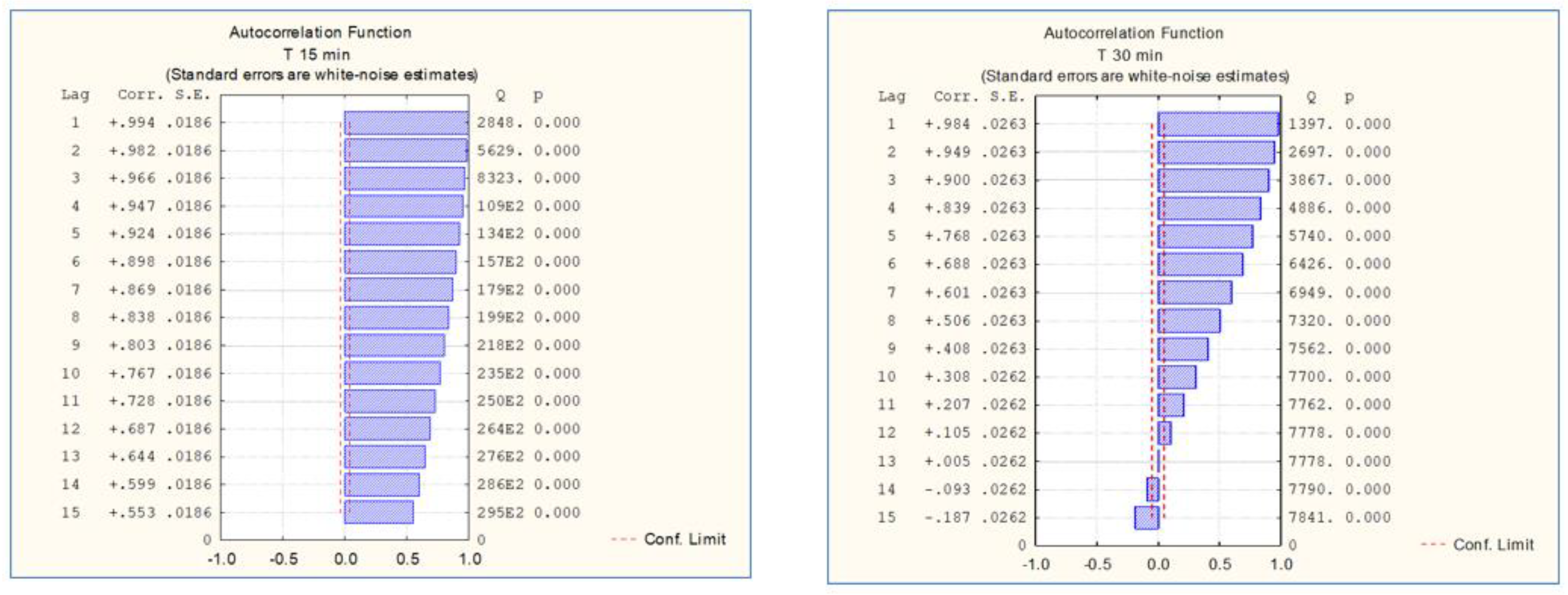
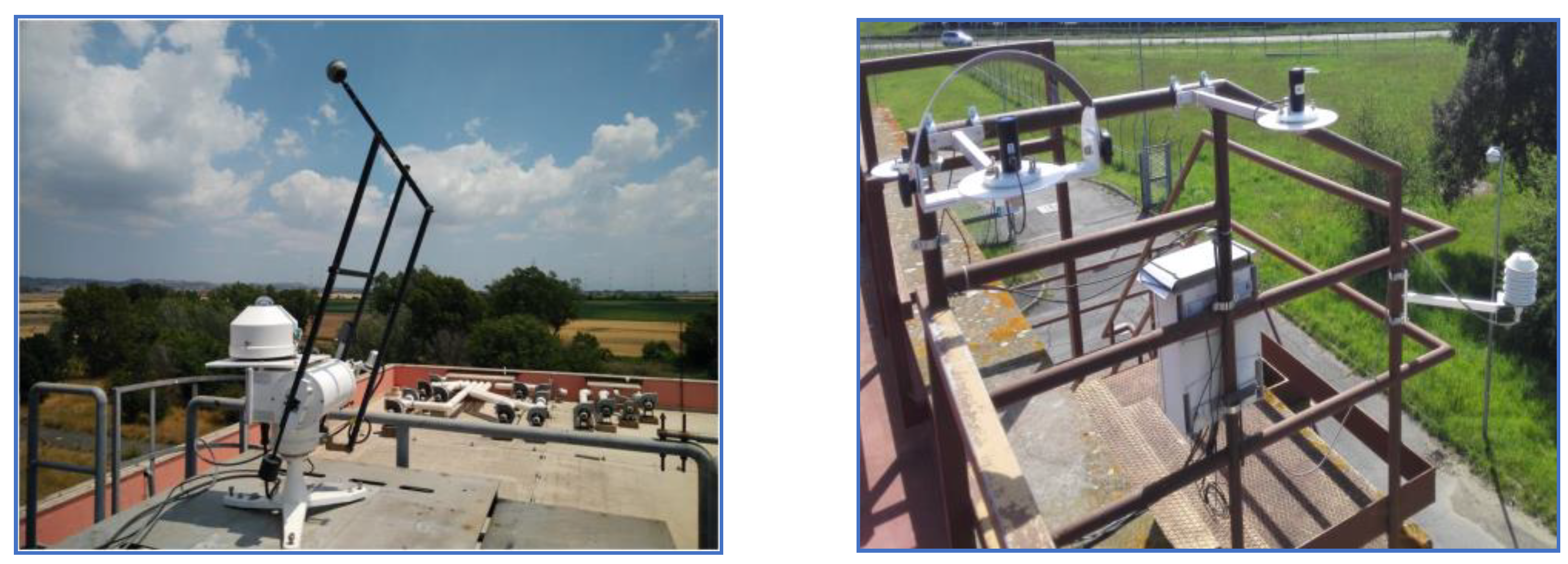

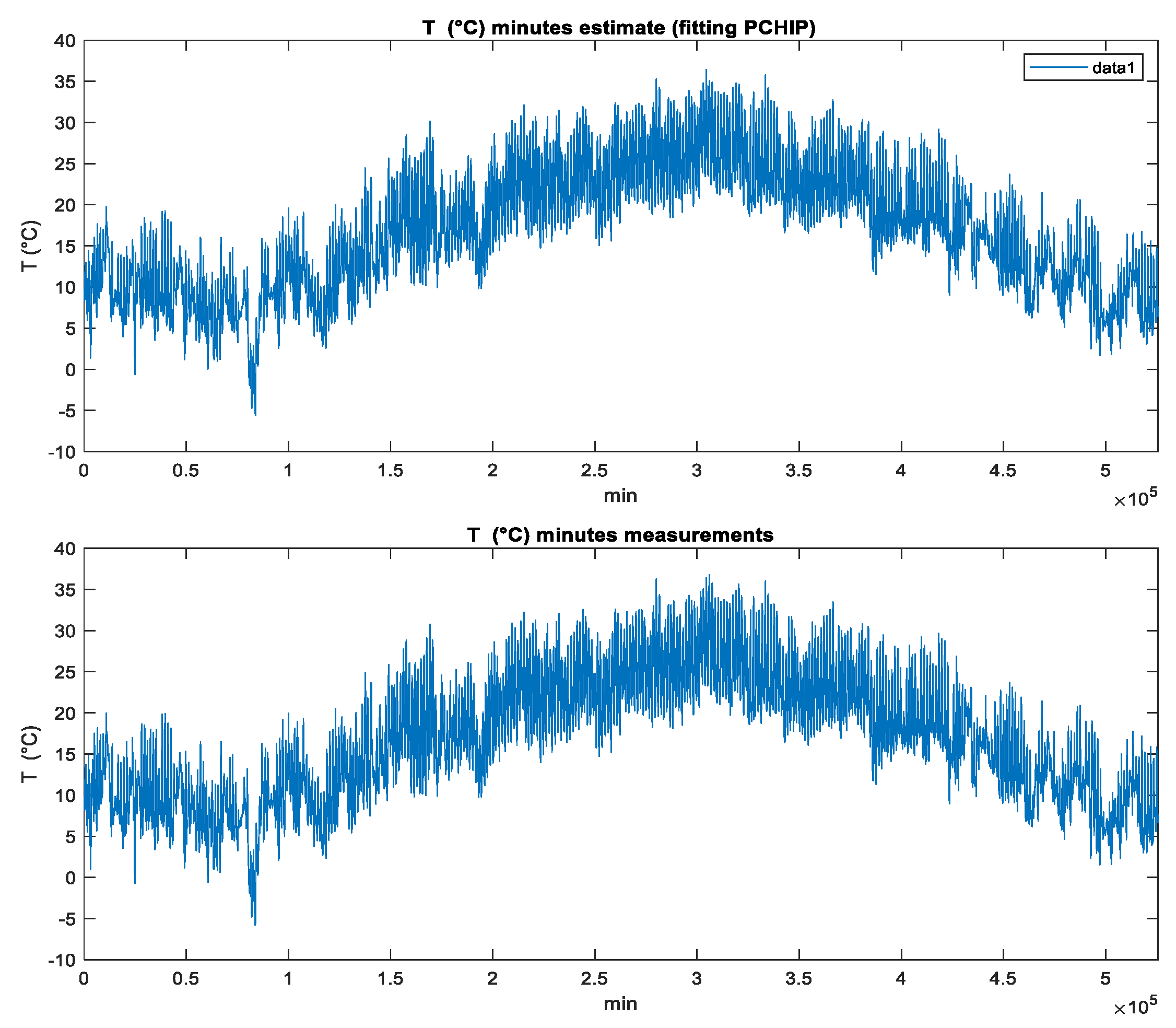
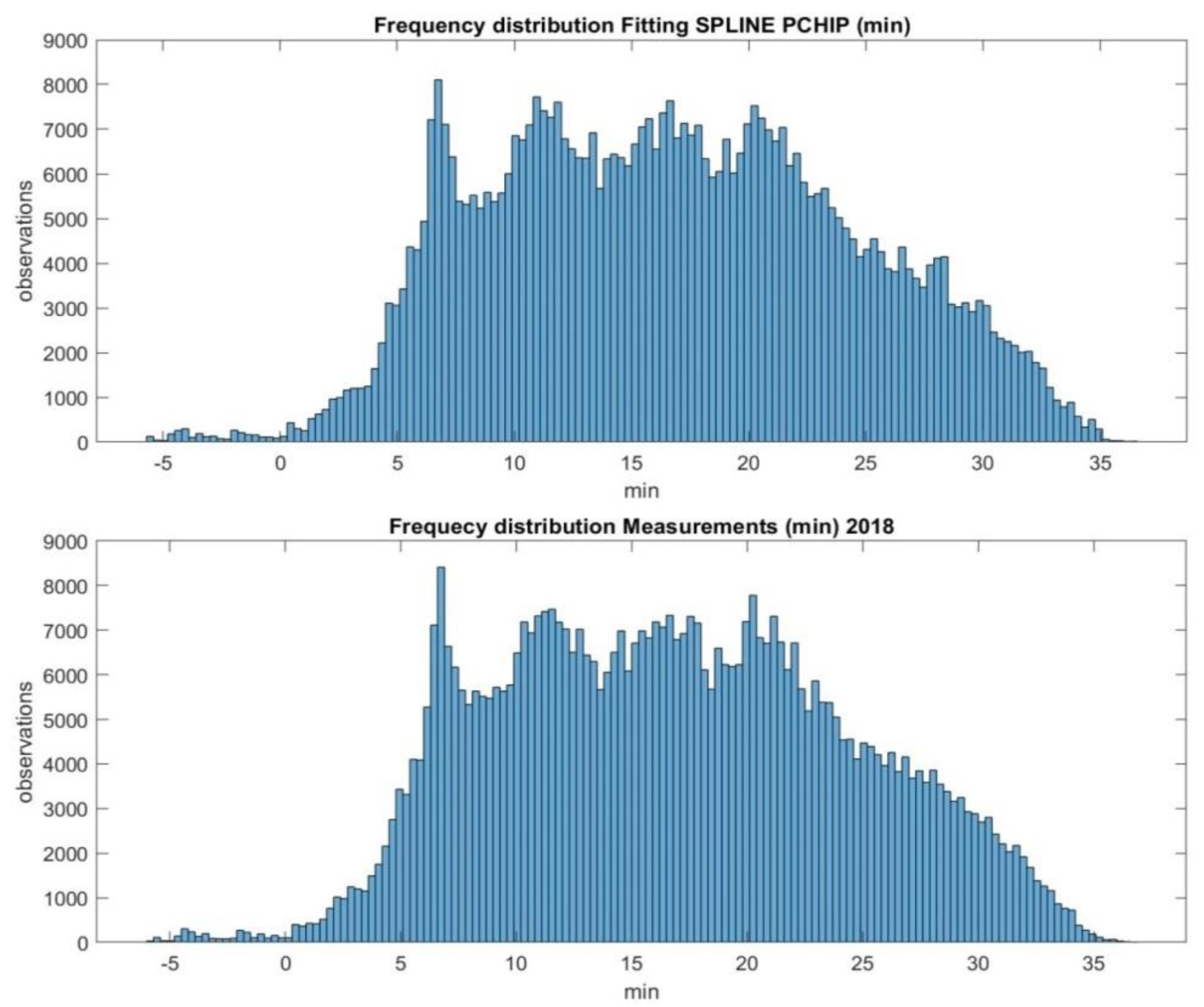


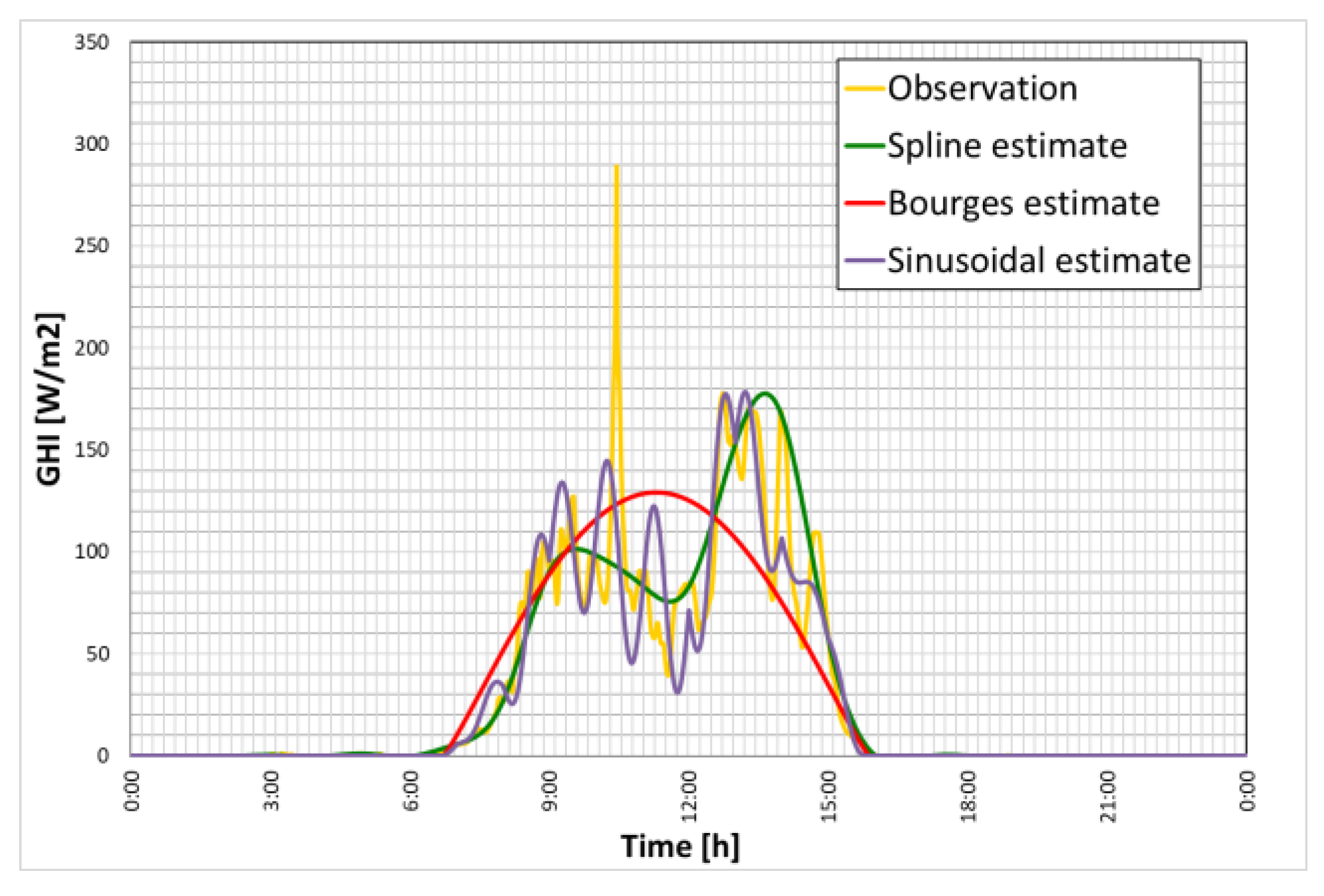
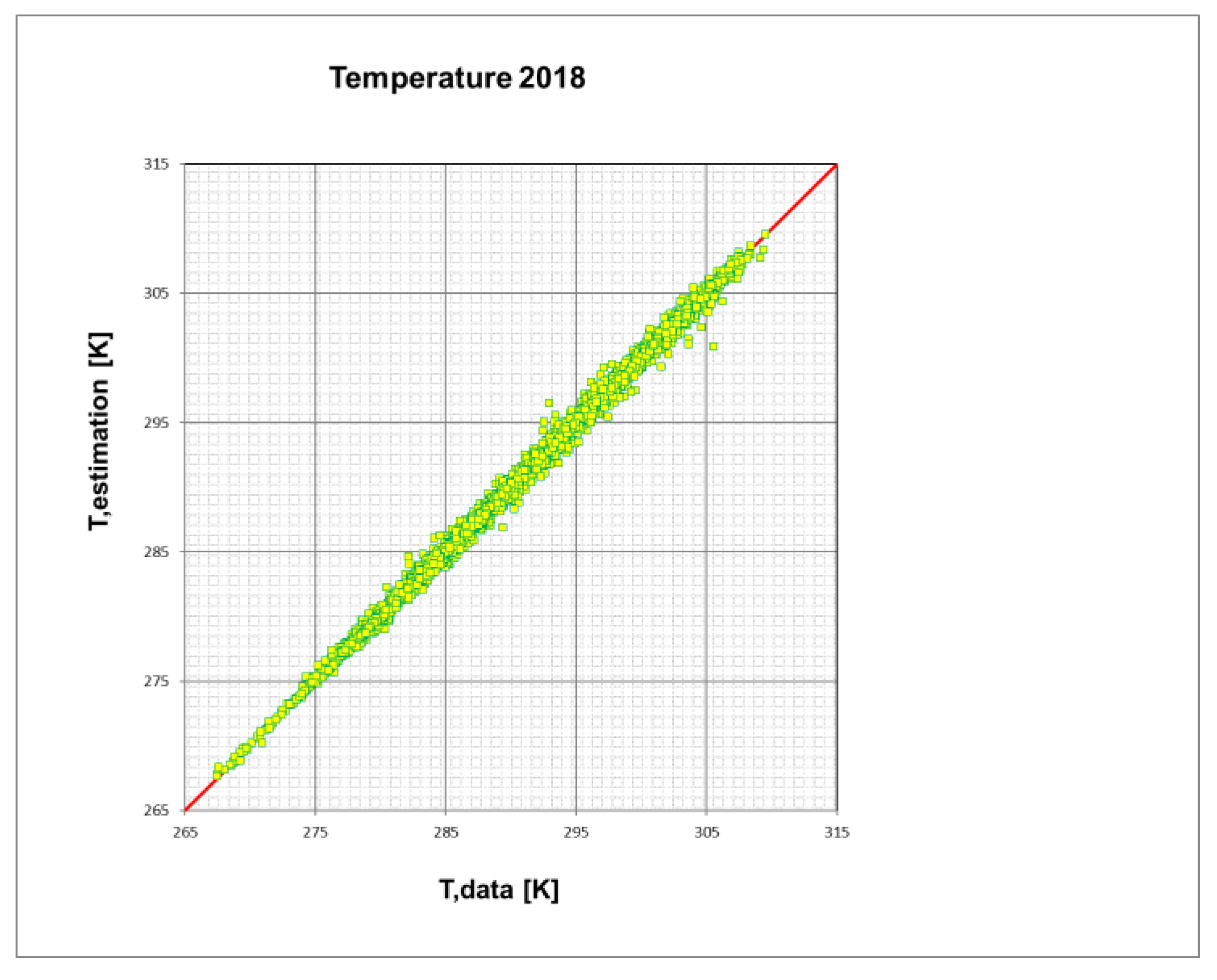
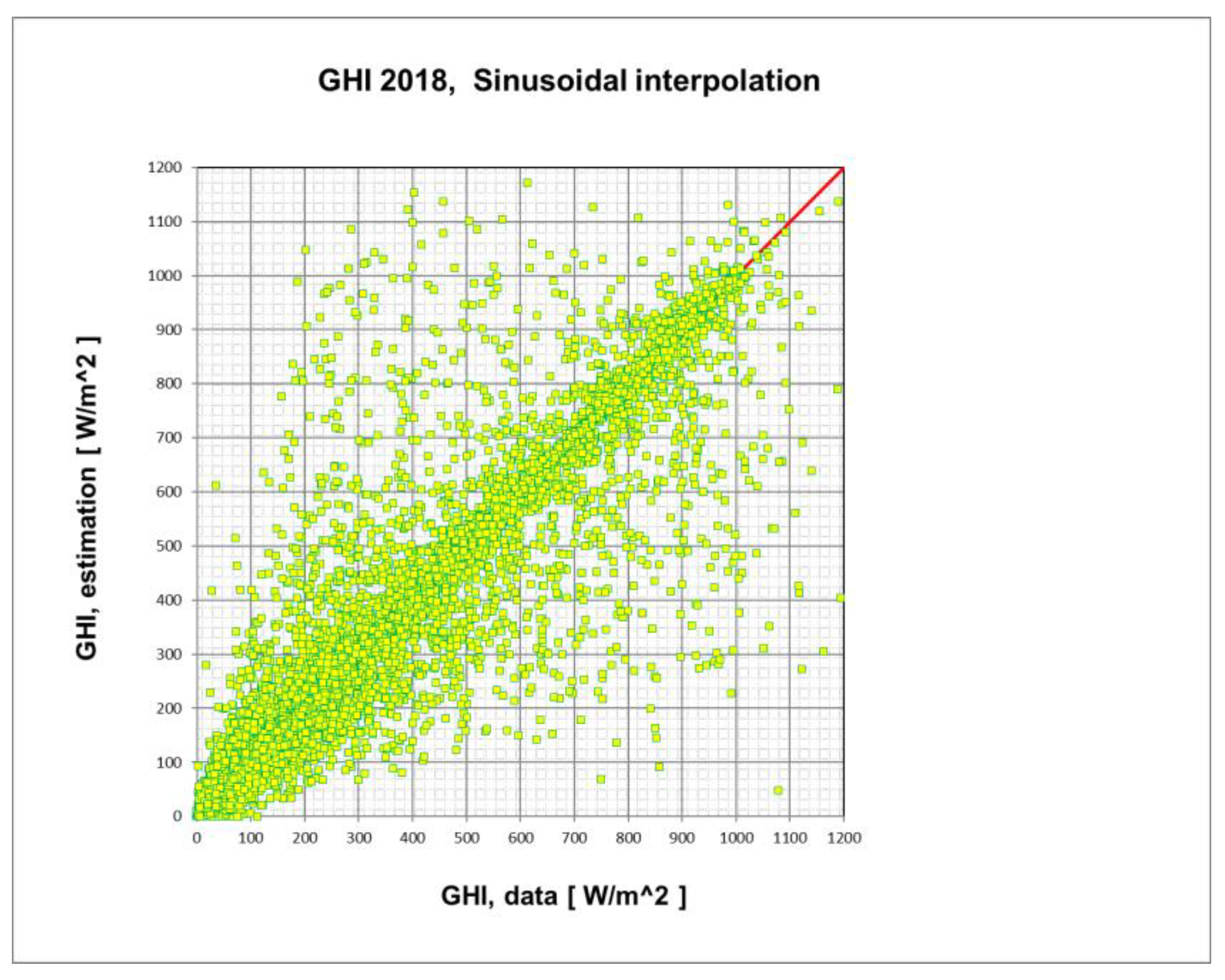
| Year 2018 | Temperature (°C) | Specific Humidity(gwater vapor/kgair) | Global Horizontal Irradiance (Only Daily Values) (W/m2) |
|---|---|---|---|
| Mean value | 16.78 | 8.61 | 350.64 |
| Standard error | 0.08 | 0.04 | 4.74 |
| Median | 16.52 | 8.26 | 277.2 |
| St. deviation | 7.69 | 3.30 | 289.98 |
| Interval | 42.02 | 16.95 | 1210 |
| Min value | −5.59 | 1.27 | 0 |
| Max value | 36.43 | 18.22 | 1210 |
| Type of Sky | Number of Days in 2018 |
|---|---|
| kc < 0.65—cloudy | 242 |
| Kc ≥ 0.65—clear sky | 120 |
| Sub-Hourly Interpolation Methods | Applicability |
|---|---|
| Spline interpolation (PCHP) | Clear sky |
| Physical model of Bourges with daily values of B | Clear sky |
| Physical model of Bourges with hourly B values | Clear sky |
| Sinusoidal–physical model | Sky with any degree of cloudiness |
Disclaimer/Publisher’s Note: The statements, opinions and data contained in all publications are solely those of the individual author(s) and contributor(s) and not of MDPI and/or the editor(s). MDPI and/or the editor(s) disclaim responsibility for any injury to people or property resulting from any ideas, methods, instructions or products referred to in the content. |
© 2023 by the authors. Licensee MDPI, Basel, Switzerland. This article is an open access article distributed under the terms and conditions of the Creative Commons Attribution (CC BY) license (https://creativecommons.org/licenses/by/4.0/).
Share and Cite
Balog, I.; Caputo, G.; Iatauro, D.; Signoretti, P.; Spinelli, F. Downscaling of Hourly Climate Data for the Assessment of Building Energy Performance. Sustainability 2023, 15, 2762. https://doi.org/10.3390/su15032762
Balog I, Caputo G, Iatauro D, Signoretti P, Spinelli F. Downscaling of Hourly Climate Data for the Assessment of Building Energy Performance. Sustainability. 2023; 15(3):2762. https://doi.org/10.3390/su15032762
Chicago/Turabian StyleBalog, Irena, Giampaolo Caputo, Domenico Iatauro, Paolo Signoretti, and Francesco Spinelli. 2023. "Downscaling of Hourly Climate Data for the Assessment of Building Energy Performance" Sustainability 15, no. 3: 2762. https://doi.org/10.3390/su15032762
APA StyleBalog, I., Caputo, G., Iatauro, D., Signoretti, P., & Spinelli, F. (2023). Downscaling of Hourly Climate Data for the Assessment of Building Energy Performance. Sustainability, 15(3), 2762. https://doi.org/10.3390/su15032762







